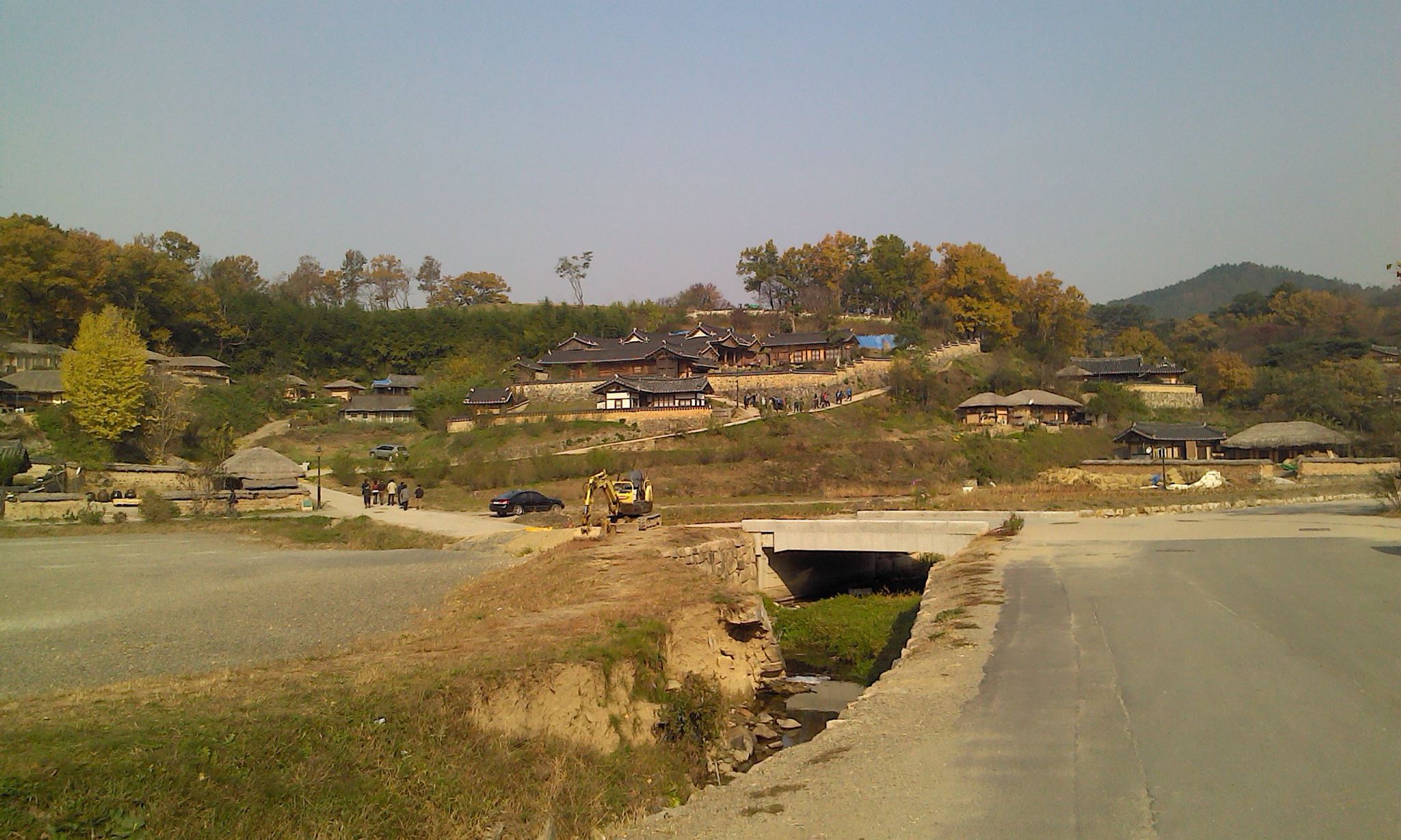Yangdong Village Of Gyeongju on:
[Wikipedia]
[Google]
[Amazon]
 Yangdong Folk Village () is a traditional '' yangban'' (upper class) Korean folk village that dates to the
Yangdong Folk Village () is a traditional '' yangban'' (upper class) Korean folk village that dates to the
A picture of the village as you enter it.
Important folk materials at the village include: *Seobaekdang (No. 23) *Nakseondang *Sahodang *Sangchunheon *Geunam Manor *Dugok Manor *Sujoldang *Ihyangjeong *Suunjeong *Simsujeong *Allakjeong *Ganghakdang Other cultural properties include: *Jeokgae Gongsin Nonsang Rokgwan (Tangible Cultural Property No. 13) *Sonso's Will (Tangible Cultural Property No. 14) *Pine Tree in Yangdong *Daeseongheon *Son Jong-ro Jeongchungbigak (Cultural Asset Material No. 261) *Gyeongsan Seodang (Folk Cultural Asset Material) *Dugok Yeongdang (Folk Cultural Asset Material). The village follows the topography of the mountains and valleys and is shaped like an auspicious
Gwangajeong House 02.jpg, Gwangajeong House
Hyangdan House 02.jpg, Hyangdan House
Seobaekdang House.jpg, Seobaekdang House
Yangdong Village 07.jpg, Inside court of a house
2008-Korea-Gyeongju-Yangdong Village-01.jpg,
Korea-Gyeongju-Yangdong.Village-02.jpg,
Website of Yangdong Village
UNESCO
Visit Korea
World Heritage in Korea
(pdf) {{World Heritage Sites in South Korea Folk villages in South Korea World Heritage Sites in South Korea Tourist attractions in North Gyeongsang Province National Folklore Cultural Heritage of South Korea Buildings and structures in Gyeongju
 Yangdong Folk Village () is a traditional '' yangban'' (upper class) Korean folk village that dates to the
Yangdong Folk Village () is a traditional '' yangban'' (upper class) Korean folk village that dates to the Joseon
Joseon ( ; ; also romanized as ''Chosun''), officially Great Joseon (), was a dynastic kingdom of Korea that existed for 505 years. It was founded by Taejo of Joseon in July 1392 and replaced by the Korean Empire in October 1897. The kingdom w ...
period. The village is located in Gangdong-myeon, sixteen kilometers northeast of Gyeongju
Gyeongju (, ), historically known as Seorabeol (, ), is a coastal city in the far southeastern corner of North Gyeongsang Province, South Korea. It is the second largest city by area in the province after Andong, covering with a population of ...
, South Korea, along the Hyeongsan River. Mt. Seolchang stands to the north of the village. The village is designated as Important Folklore Materials No. 189 by the South Korean government.
The size, degree of preservation, numerous cultural assets, traditionalism, beautiful natural setting all contribute to the importance of Yangdong Village. It is also a fine example of the yangban (Korean aristocracy) lifestyle and Neo-Confucian traditions.
The village is listed by the South Korean government with UNESCO
The United Nations Educational, Scientific and Cultural Organization (UNESCO ) is a List of specialized agencies of the United Nations, specialized agency of the United Nations (UN) with the aim of promoting world peace and International secur ...
as a World Heritage Site
World Heritage Sites are landmarks and areas with legal protection under an treaty, international treaty administered by UNESCO for having cultural, historical, or scientific significance. The sites are judged to contain "cultural and natural ...
with Hahoe Folk Village in 2010.
Overview
The village was founded by Son So (孫昭 1433–1484). The household of the Wolseong Son clan was placed on an auspicious site according to Korean theories of ''pungsu'' (geomancy
Geomancy, a compound of Greek roots denoting "earth divination", was originally used to mean methods of divination that interpret geographic features, markings on the ground, or the patterns formed by soil, rock (geology), rocks, or sand. Its d ...
). Son So and his wife, the daughter of Yu Bok Ha had a daughter who married Yi Beon of the Yeogang Yi family. The marriage produced one of the eighteen sages of Korea, Yi Unjeok. The village of Yangdong has continued since its auspicious beginning in the 15th century.
Although some of the village is unoccupied today, overall the village has over 160 tile-roofed and thatched-roof homes built throughout the dense forest. Fifty-four historic homes over 200 years old have also been preserved. The village preserves folk customs as well as traditional buildings of traditional Joseon dynasty architecture. Seobaekodang is the primary home of the Wolseong Son Family. Mucheomdang, is the primary house of the Yeogang Yi family. Hyangdan is National Treasure No. 412. Ihayangjeon and Simsujeong pavilions, and the Ganghakdang village school are also notable structures of the village as well as Gwangajeong and Sonsoyeongjeong. Tonggamsokpyeon, a book printed on movable metal type and National Treasure No. 283, is also located in the villageA picture of the village as you enter it.
Important folk materials at the village include: *Seobaekdang (No. 23) *Nakseondang *Sahodang *Sangchunheon *Geunam Manor *Dugok Manor *Sujoldang *Ihyangjeong *Suunjeong *Simsujeong *Allakjeong *Ganghakdang Other cultural properties include: *Jeokgae Gongsin Nonsang Rokgwan (Tangible Cultural Property No. 13) *Sonso's Will (Tangible Cultural Property No. 14) *Pine Tree in Yangdong *Daeseongheon *Son Jong-ro Jeongchungbigak (Cultural Asset Material No. 261) *Gyeongsan Seodang (Folk Cultural Asset Material) *Dugok Yeongdang (Folk Cultural Asset Material). The village follows the topography of the mountains and valleys and is shaped like an auspicious
Hanja
Hanja (; ), alternatively spelled Hancha, are Chinese characters used to write the Korean language. After characters were introduced to Korea to write Literary Chinese, they were adapted to write Korean as early as the Gojoseon period.
() ...
character. This arrangement has been carefully preserved. The homes of the Wolseong Son and Yeogang Yi clans, as well as their descendants' homes are located on the high ground of the mountains and valleys. The lower-class homes, characterized by their thatched roofs were built on lower ground. The village's organization highlights the severe social stratification characteristic of Joseon dynasty society. Prince Charles visited Yangdong in 1993.
Gallery
See also
* Hahoe Folk VillageReferences
External links
Website of Yangdong Village
UNESCO
Visit Korea
World Heritage in Korea
(pdf) {{World Heritage Sites in South Korea Folk villages in South Korea World Heritage Sites in South Korea Tourist attractions in North Gyeongsang Province National Folklore Cultural Heritage of South Korea Buildings and structures in Gyeongju